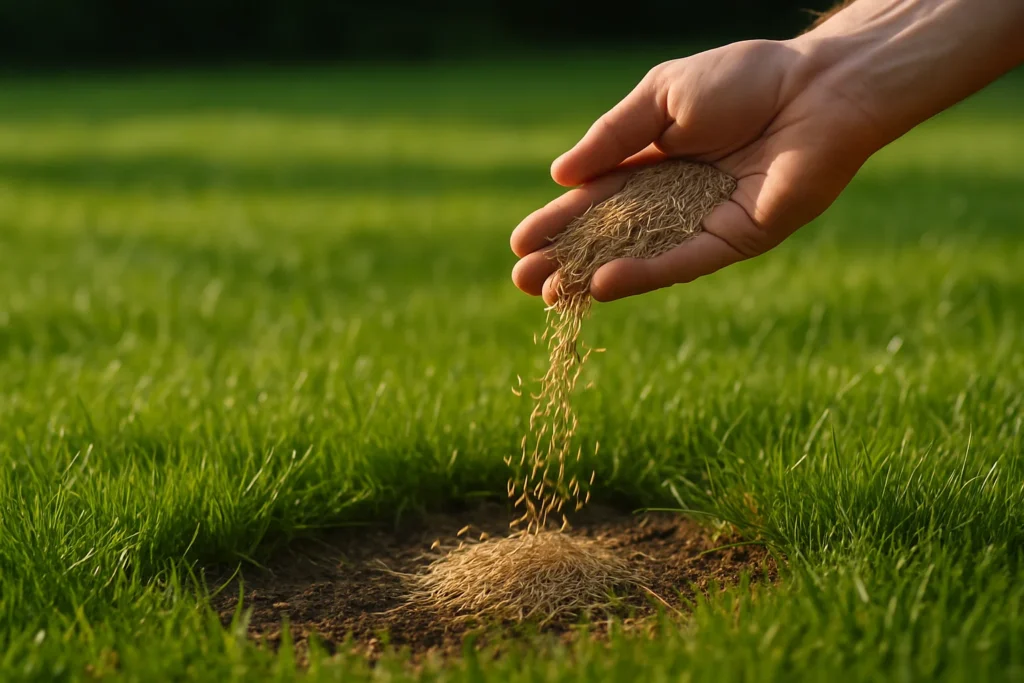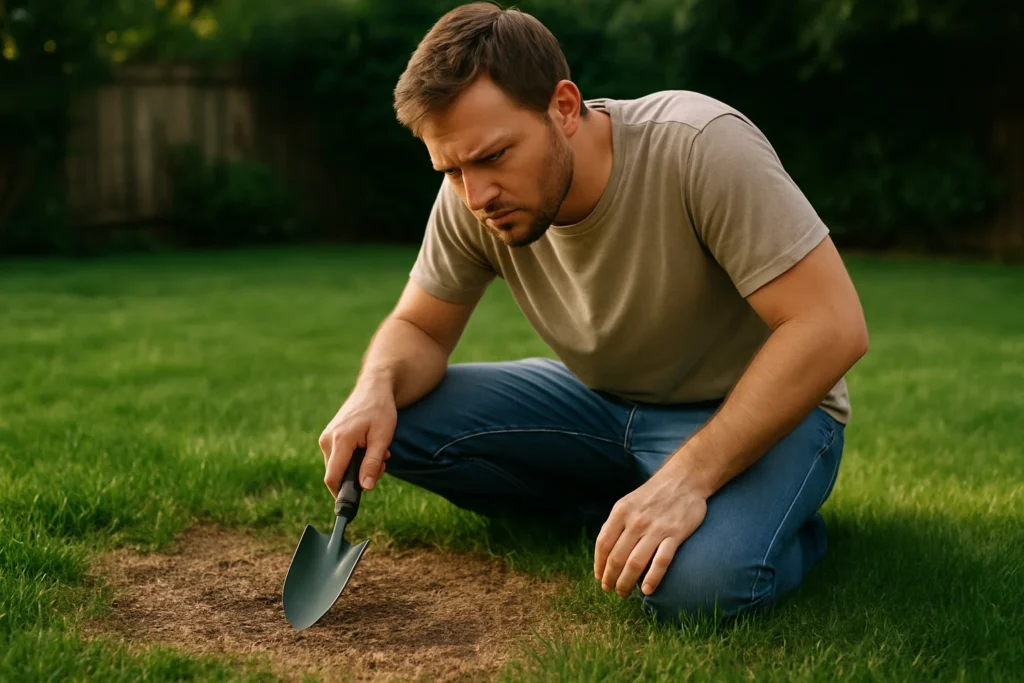Planting grass seed is one of the most reliable and cost-effective ways to establish a lush, inviting lawn, regardless of the season. Unlike sod and artificial turf, seeding your lawn establish deep, strong roots that withstaand seasonal stress, heavy traffic and environmental challenges. Whether you’re starting with an empty yard, just a few thin spots, the key to successful seeding begins long before the first seed hits the ground. It includes timing, seed variety, soil preparation, and care to encourage a strong, even spread. In this guide, you will learn how to plant grass seed as a professional. From understanding what types of grass grow best in your area to avoiding the most common mistakes, we grow a lawn that’s not just green, but built to last.
Why Planting Grass Seed Is the Key to a Healthy Lawn
Seeding your lawn is not only about aesthetics; it’s a long-term decision for your lawn. Whether you are patching bare spots, seeding a new lawn, or overseeding your lawn for thicker growth, properly planting grass seed gives it the optimal chance to grow thick and stay healthy.
Benefits of Seeding Your Lawn
- Fills in and covers up the thinning and balding areas for a more uniform look
- Enhances turf density, helps to inhibit weed growth
- Improves the lawn’s ability against drought and disease
- and stress from pests
- Cheaper than sod, especially in large areas
When Is the Best Time to Plant Grass Seed in the U.S.?
Timing is everything. Here’s a quick breakdown:
- Cool-Season Grasses (Fescue, Bluegrass): Early fall (late August-October) or early spring
- Warm-Season Grasses (e.g., Bermuda, Zoysia): Late spring to early summer
Step-by-Step Guide: How to Plant Grass Seed
Smart prep is the key to a strong lawn. Starting a healthy lawn from seed does not have to be guesswork. This section instructs you in everything from soil testing to your first watering schedule, so that you can skip patchy growth and wasted time. Whether you’re a beginner or you want to refine your skills, these steps give you a dense and thriving lawn that begins to grow from the ground up. Follow these six fundamental steps to get your seeds started effectively.
Step 1 – Test and Prepare Your Soil
Before anything else, test the pH of your soil (optimal range: 6.0–7.0). You can purchase a DIY test kit or contact your local extension services.
- If heavily compacted, generalize to aerate the soil
- Clear rocks, weeds, and junk
- Rake or till the top 2–3 inches to loosen the soil.
- Incorporate compost or topsoil if there are poor drainage or nutrient levels issues.

Step 2 – Choose the Right Grass Seed for Your Region
Match the variety of grass to your local climate:
- Northeast & Midwest: Kentucky Bluegrass, Perennial Ryegrass, Fine Fescue
- Southeast: Bermuda, Zoysia, Centipede
- West Coast: Tall Fescue (cool), Bermuda (warm)
Examine the seed label for the germination rate and non-germinating material. Each fertilizer saves me time and frustration with higher-quality seed.
Step 3 – Clear and Level the Lawn Area
Uneven ground leads to the pooling of water and inconsistent growth.
- Rake out dead grass, roots, and clumps
- Top with topsoil in low spots
- Use a lawn roller to smooth out bumps.
Step 4 – Spread the Grass Seed Evenly
Distribute the seed with a broadcast or drop spreader:
- Apply in two directions – one north-to-south, one east-to-west
- Stick to recommended seeding rate (usually listed per 1,000 sq ft)
- For overseeding , use half the full rate
Step 5 – Cover the Seeds with Soil or Straw
Grass seed needs contact with the soil and protection from the elements:
- Gently rake to combine seeds with the top ¼ inch of soil
- Apply a light layer of weed-free straw or peat moss to retain the moisture.
- Avoid thick mulches that block out the sun.
Step 6 – Watering Schedule for New Grass Seed
Water is a germination dealbreaker:
- Initial watering: Water immediately after planting.
- Days 1–14: Water slowly, ensuring the top 1 to 2 inches of soil are consistently moist
- After germination: Decrease frequency, increase depth (water deeply 2-3 times/week)
- Peak times: Early morning and early evening
Common Mistakes to Avoid When Planting Grass
Some even well-intentioned homeowners can undermine their seeding success. From the best of intentions, there are a few lawn projects that inevitably lead to DIY lawn projects. In this section, we spotlight the most frequent mistakes, such as selecting the wrong seed, skipping soil prep, or mishandling irrigation, and explain what you can do to correct or avoid them. By knowing these, you can take steps to protect your investment and get your lawn off to a good start. Here’s what to watch for:
Overwatering or Underwatering
Excess water can drown seeds and promote fungal diseases
Too little water dries out before it germinates
Wet but not soaked is a good target here.
Using the Wrong Seed Type
Grass that isn’t meant for your climate or for your yard’s condition (sun/shade) will fail, no matter how well you plant it.
Not Prepping the Soil Properly
To avoid prepping the soil is like planting in concrete. Without loosened, nutrient-rich soil, even the best seeds will struggle.
Overseeding vs. Planting Grass Seed from Scratch
Not sure whether to start fresh or improve your existing lawn? This section outlines the key differences between overseeding and seeding from scratch. You will learn when each method is appropriate, how they are unique, and which will provide the best long-term impact for your lawn given its current condition. Each relies on grass seed , but with different aims and methods.
What Is Overseeding and When Should You Do It?
Overseeding involves planting new seed over an existing lawn to boost its density or repair patches, without removing the current turf. Ideal for:
- Thinning lawns
- Moving to a better grass type
- Post-summer stress
Is It Better to Reseed or Start Over?
Resow (overseed) if 40-50% of your lawn is in good condition.
Start over if you currently have a lawn covered in weeds, has bad soil, or experiences compacted and drainage issues
New beginnings require more work, but can also be more effective long-term.

Troubleshooting Patchy or Poor Grass Growth
Uneven or patchy grass growth is a frequent issue that most lawn owners face. Several factors can contribute to this problem:
- Bad Watering: Under and over-watering cause a brown patch or dead spots. Less water is harmful to the grass as it dries out the grass, whereas too much water is harmful as it suffocates the roots and promotes the growth of fungal diseases.
- Soil Compaction: Compacted soil becomes hard and nutrients in the soil are blocked, hindering root growth and making the turf weak. Lawn aeration will decrease compaction and encourage healthy growth.
- Soil of poor quality: Soil with a deficiency of nutrients or improper pH conditions makes grass weak. The appropriate amendments that restore balanced nutrition are a soil test and subsequent amendments.
- Thatch Buildup: The presence of excess thatch traps water and nutrients and does not allow them to reach roots and thin the lawn. The growing season dethatching rejuvenates the turf.
- Fungal Diseases and Pests: Fungus grows in shaded areas and forms irregular spots. Roots are attacked by pests like grubs and mowed off by them.
- Improper Mowing Patterns: Mowing it too short or more patchy is an indicator of inadequate mowing habits that overload the lawn.
Proper watering, aeration, care of soil, pest management, and mowing will assist in correcting such causes to get a lush and even lawn.
Maintenance Tips After Planting Grass Seed
It’s not enough to just get the seed in the ground. It is vitally important to condition the soil in the first few weeks after root development, for moisture retention, and pest prevention. This section covers all the fundamentals of maintaining your lawn, including when to mow, how to fertilize, and how to protect it from pests and weeds — plus pro tips for keeping it green and irritant-free. The first few weeks after planting are critical to your lawn’s success.
First Mowing After Seeding
- Wait until the grass is 3 or 4 inches tall
- Pull out that sharp blade and mow high.
- Avoid heavy traffic on the lawn for at least 3 – 4 weeks
Fertilizing Schedule for New Grass
- Avoid fertilizing immediately unless using a seed starter with fertilizer
- 3-4 weeks: Apply slow-release nitrogen fertilizer.
- Proceed with feeding your lawn seasonally (spring and fall for cool-season lawns).
How to Protect Young Grass from Pests and Weeds
- Do not apply herbicide during the first 6 to 8 weeks of seeding.
- Hand pull weeds until the grass is established.
- Watch for pests like grubs and birds eating the seeds
Conclusion:
Are you learning how to plant grass seed properly to save time, money, and countless headaches in the future? By choosing the right seed, preparing the soil, and taking care of your new lawn in the first few weeks, you are laying the groundwork for years of healthy, green growth. Whether patching your yard or starting from scratch, the success lies in the details — and you have all of them now.
FAQs:
Not if you want results. Grass seed needs soil contact, proper moisture, and light cover to germinate properly.
Perennial Ryegrass germinates in 5-10 days and is ideal for high-traffic areas in cool-season regions.
Yes, particularly if your soil is compacted. Aerification also enhances seed-to-soil contact and root development.
Only warm-season grasses should be planted in the summer. Cool-season grasses will struggle in high heat and drought.
Most varieties of grass will germinate within 7–21 days. Under ideal growing conditions, you can expect to see greenery on your lawn in 3–5 weeks.



